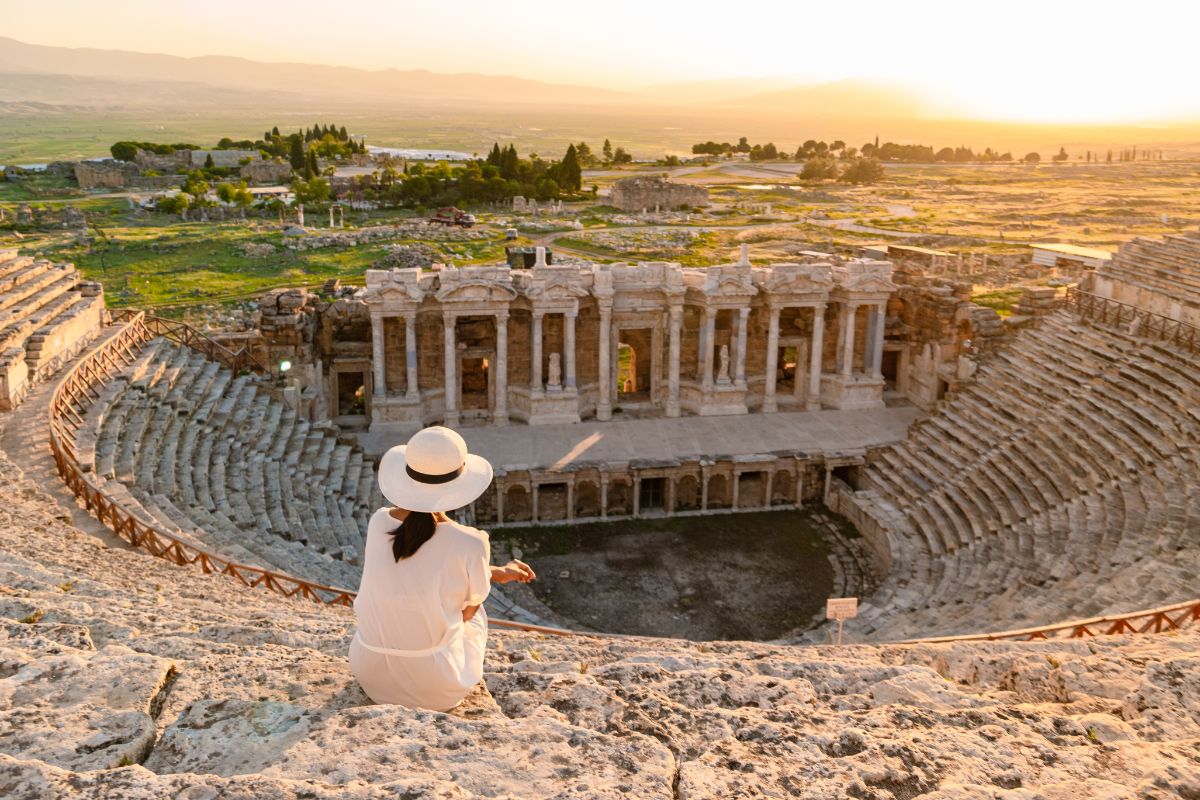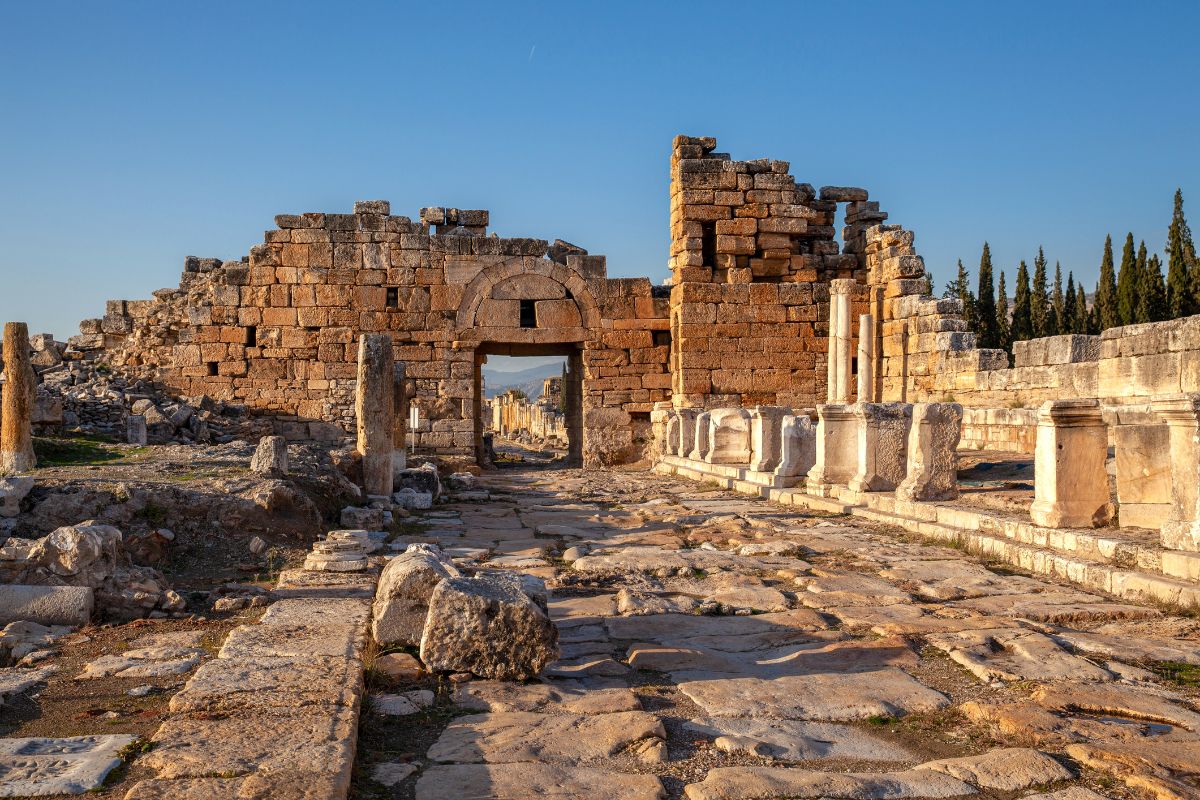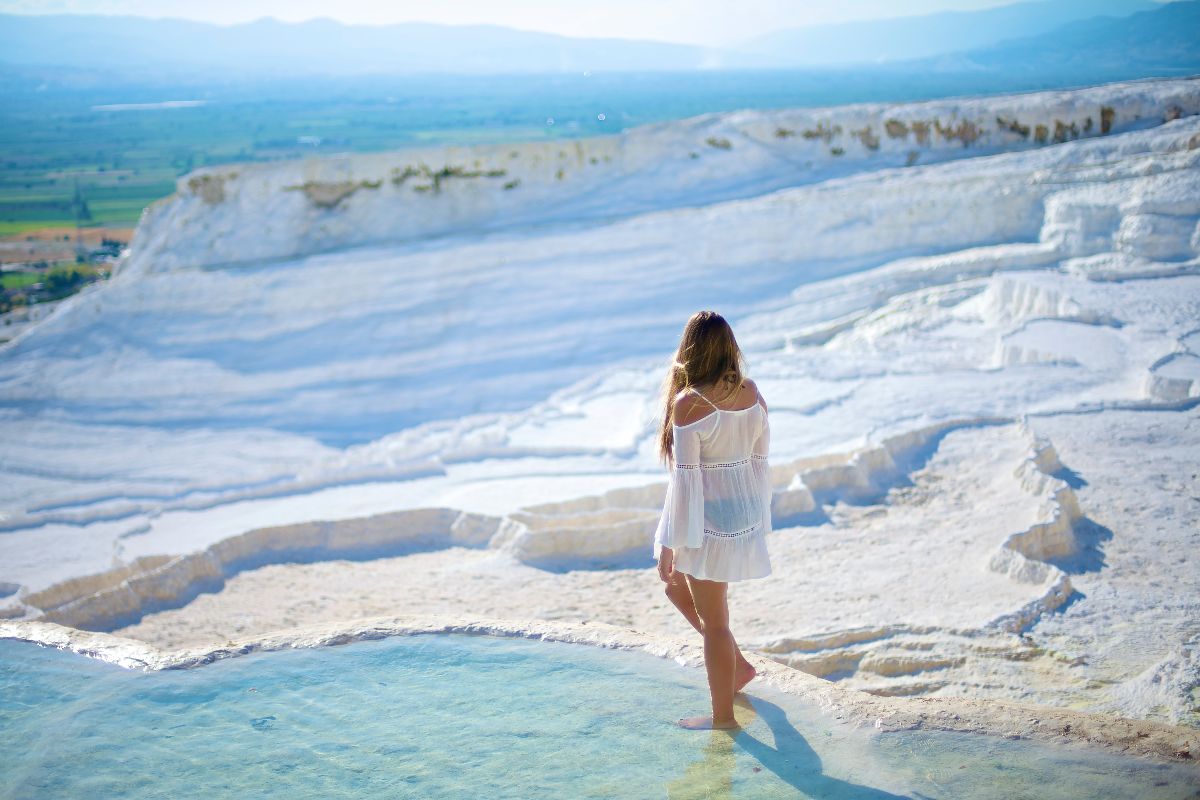Visiting Hierapolis and Pamukkale is like traveling to a fabled world of the past.
Fabulous, because the white travertine terraces that are located here look like something out of a fairy tale.
And to the past, because the spa town that once flourished here still preserves spectacular monuments and archaeological remainsamong the best in Ancient Greece.
So if you are seduced by the idea of walking around here and even take a dip in its hot springs, in the following lines we offer you all the information you need to know.
Hierapolis and Pamukkale are two tourist destinations in one, in the Denizli province of province of Denizliin the southwestern sector of Anatolia.
On the one hand, Pamukkale is the village of about 2,000 inhabitants that gives its name to the natural park on its outskirtsIt is characterized by the spectacular outcropping of white calcite travertines in terraces, all ‘watered’ by thermal waters that flow here and are dammed in small pools.
And on the other hand, Hierapolis is the ancient spa city that arose next to these travertine outcropslocated about 3 km from the actual town of Pamukkale and at the foot of the natural area.
While the village of Pamukkale is at a lower elevation of the travertines, the city of Hierapolis is higher, extending over a plateau that offers spectacular views of the surrounding area from some points.
Although they are two different and interesting spaces for different reasons, the proximity between them led to their protection as a single site. a single placedeclared a Unesco Unesco World Heritage Site in 1988, under the name of Hierapolis – Pamukkale.
Actually, the name Pamukkale has a poetic and metaphorical meaning: “cotton castle”, in TurkishThis is a sign of its elevated character (when viewed from the town of Pamukkale) and the clean whiteness of the hill.
Hierapolis, on the other hand, means “sacred city” in ancient Greekwhich allows us to imagine the respect and veneration that this place had for that civilization.

The climate in Hierapolis and Pamukkale is Mediterranean Mediterraneanthat is to say, with relatively mild winters (temperatures rarely fall below 0º at night), with hot summers (35º average maximum) and scarce precipitation, concentrated in the winter and spring months, with less than 100 days of rain per year.
However, the fact that it is located in the interior of Anatolia, about 200 km in a straight line from the sea, and a certain altitude (350 meters above sea level) means that there are continental notesThe temperature of the air is usually lower in the summer months, as well as a certain thermal excursion between day and night.
In the summer months, it is advisable to protect yourself from the sun and high temperatures.
And if you are going to walk along the travertines in the central hours of the day, it is important to protect your eyes, since the light reflected on the rock and in the water can be blinding.
The great gateway to Hierapolis and Pamukkale is DenizliDenizli, the capital of the province in which these places are located.
This city, with a population of 700,000, is located just a few kilometers away from 20 minutes awayThe bus station is located 20 minutes away, so it can be taken as a reference for those who choose to travel by public transportation, such as the train or the bus.
The and convenient way to reach Hierapolis and Pamukkale is undoubtedly by plane, either by a domestic flight from other parts of Turkey or by an international flight from another country.
In fact, there are two airports that can serve this tourist destination.
The closest is Denizli Çardak Airport (IATA code: DNZ): it is located about 70 km east of Hierapolis and Pamukkale.
The problem is that the air routes it offers are only nationals and some seasonal flights from other Middle Eastern countries, mainly Iran and Saudi Arabia.
However, flights arrive here from Istanbul’s two airports (Istanbul Airport and Sabiha Gökçen Airport), so it is easy to integrate this destination into a tour of Turkey.
The other airport serving Hierapolis and Pamukkale is the airport at Izmir-Adnan Menderes (IATA code: ADB).
It is farther away than the previous one, about 240 km to the west, which is a journey time of just under 3 hours.
However, the advantage of this airport is that it does have significant air traffic, both in terms of passenger numbers as well as in domestic and international destinations it offers.
In fact, it is one of the largest in the country, with some 12 million passengers a year.
This is the list of air routes international which are usually available here:
With regard to domestic airports domestic airports that are connected to Izmir-Adnan Menderes, the list is also extensive: Adana, Ankara, Antalya, Diyarbakir, Elazig, Gaziantep, Hatay, Istanbul (both Istanbul International Airport and Sabiha Gökçen Airport), Kayseri, Mardin, Samsun, Sivas and Trebizond.
Therefore, this airport of Izmir-Adnan Menderes is an interesting option for those who wish to travel to Hierapolis and Pamukkale, either directly or making a stopover at another Turkish airport, but without visiting this destination.
The train is another possible option to reach Hierapolis and Pamukkale, although not the most advisable in terms of comfort, since the trains that reach Denizli are not high speed. high-speed trains to Denizli and, in addition, they do not come from the two main cities of the country (Istanbul or Ankara).
Therefore, if you choose this route, you will have to make various changes.
The Pamukkale Ekspresi is the train coming from EskişehirEskişehir, a city about 330 km north of Denizli and about 300 km southeast of Istanbul.
The train ride from Eskişehir takes about 8 hours.
Better rail connection is between Denizli and IzmirFrom Izmir there are about 6 trains daily to Denizli, covering the 250 km journey in about 5 hours and a half.
The good news is that Denizli train station is located across the street from the bus station. opposite the bus stationThe good news is that Denizli train station is opposite the bus station, so it will be easy to change means of transport to take a local bus to Pamukkale.
Given the tourist attraction of Hierapolis and Pamukkale, several bus companies have long distance lines to Denizli. long distance lines to Denizli.
Algunas de ellas son Metro, Kamil Koç o Pamukkale.
Algunas de estas rutas terminan en Denizli, lo que obliga al viajero a tomar un taxi desde aquí hasta Hierápolis y Pamukkale, o bien tomar otro autobús local, con una frecuencia aproximada de una salida cada 20 minutos.
Sin embargo, In other cases, the route ends directly at Hierapolis, specifically at its northern gate.specifically at its northern gate.
These bus lines come from the big cities of the country, especially Istanbul and Ankara.
But you will also find bus lines coming from relatively nearby destinations, such as Izmir and Konya (with several weekly departures), as well as the big sun and beach tourist destinations, such as Fethiye or Bodrum (with daily departures).
If your idea is to make a circuit by car, either rental or in a vehicle with driver as those provided by our agency, you must take into account the following distances and approximate durations, to assess how to fit this stage in your program.
In this case, we take Pamukkale as the final reference destination:
As is the case with any other site of geological interest, such as Cappadociathe history of Pamukkale must be measured not only in human time, but also in geological time. geological timeThe travertine terraces (white calcite) were formed over thousands and thousands of years.
In this case, by the changes in the earth’s crust caused by earthquakes and tectonic movements and tectonic movements, and the consequent progressive sedimentation of bicarbonate and calcium, deposited here by the thermal waters that rise in the area and flow downhill.
In some cases, these waters have been naturally dammed, forming small pools.
In others, the water has disappeared, resulting in the aforementioned travertine terraces.
Many times, erosion itself has chiseled the most striking rock formations, making the imagination of those who contemplate them fly, including stalactites and stalagmites as if they were ice frozen in time.
Such a special place, as it could not be otherwise, attracted the attention of the ancient inhabitants of this part of Anatolia.
Not so much for its unparalleled beauty, but above all for the use of its waters.
The first architect of this was King Eumenes II of Pergamon, around 190 B.C.when he founded a treatment center here, as well as a center for the worship of the center for the worship of the goddess Cybele..
De esa ciudad frigia derivó la posterior ciudad griega, cuyo nombre Hierápolis significa “ciudad sagrada”.
However, geology has not always been benign here and, although it has favored the creation of this cotton castle, it has also trembled on several occasions, in a devastating manner.
One of the first earthquakes documented took place in the first century A.D. I century A.D.The city collapsed and had to be rebuilt.
Because of this, the city collapsed and had to be rebuilt.
Therefore, the vast majority of what can be seen here has a Roman and not Hellenistic character.
In any case, after the reconstruction, Hierapolis reached its period of splendorespecially in the 2nd and 3rd centuriescenturies, when it became a great spa center for the upper classes, who came here from very different corners of the Empire.
By this time, the Jewish population also grew and became numerous.
And the number of Orthodox Christians centuries later.
El prestigio de Hierápolis como destino termal se mantuvo durante la época bizantina, pero también se vio sumida en different disasters.
En algunos casos, por invasions destructive invasions, such as that of the Persians in the 6th century or the disputes between the Seljuk Sultanate of Konya and the Crusaders in the 12th century, falling into the hands of the former.
And in other cases, due to new earthquakesthe most devastating being the one that occurred in 1354which led to the definitive abandonment of the city.
Y así, bajo los escombros y bajo una capa de sedimentos, se mantuvo hasta que se iniciaron las modern excavations at the end of the 19th centuryThe archaeological site was restored to its former splendor and the Hierapolis Archaeological Museum, which displays the most important pieces of the site, was created.
At the same time, the tourist boom of the 20th century has favored the flourishing of the town of Pamukkale that, in spite of its small size, offers all the necessary services to the traveler who visits this natural area and its archaeological site.

As can be seen from the name given to this destination, the points of interest are distributed in two areas two areasThe two sites are separated by a road that allows some mobility for visitors, but nevertheless form a single enclosure with entrance control and a single entrance and exit control.
They are separated by a road that allows a certain mobility to visitors but, nevertheless, they form a single enclosure with controlled entry and exit. three entrancesThe south gate (closest to Pamukkale village), the north gate (closest to Hierapolis) and the central/east gate (closest to the pools), so the choice of starting from one area or the other will determine the route.
The white hill that rises above the town of Pamukkale exerts an extraordinary magnetic extraordinary magnetismdifficult to describe.
Its beauty is visible from afar, like a strange snowy slope all year round.
But this beauty is also evident from the inside, when you walk through its travertines and even when you touch it. its rock, softer than it might seem.
In this natural area of travertine terracesthe traveler can walk, get lost, stop, dive into a poolThe more you go away from the entrance, the more quiet you will find, bearing in mind that the number of visitors is always high.
The further you go away from the entrance, the more quiet you will find, taking into account that the influx of people is always high.
The most perfect and beautiful travertine terraces are indicated by signs, but the route through this magical environment is free and intuitive.
On the other hand, the town of Pamukkale, of recent character and emerged in the heat of the tourist pull of the travertines, does not offer great attractions for the visitor, beyond its rhythm of local life when the hustle and bustle of tourists disappears.
If the visit to the area of the ‘cotton castle’ has a rather free and intuitive character, the visit to Hierapolis can be organized by means of itineraries This is an extraordinary site so as not to miss any point of interest.
There are many, and this list gathers those that no traveler should miss:
Walking around Hierapolis is like visiting an open-air museum.
But, in reality, it has its own archaeological museum to show in better conservation conditions the most important archaeological pieces found here.
It is divided into different sections, highlighting the necropolis, with spectacular tombs and sarcophagi.
Its collection of statues is also of great wealth and demonstrates the mastery of the artists of antiquity to represent the human anatomy, clothing and other details of great elegance.

If you have time, you can enter the so-called Ancient Swimming Pool or Cleopatra’s Swimming Pool… although this Egyptian queen-pharaoh never bathed here.
Although it is inside the enclosure, to access it you have to pay a separate entrance fee.
Its construction is recent, but bathing in its pool with mineral waters at 36º is the best way to enjoy this natural resource, to which health benefits are attributed.
The balloon ride is another of the favorite proposals of travelers who do not want to lose detail.
Although the history of Hierapolis is appreciated up close and the beauty of the travertines and the waters of Pamukkale are enjoyed by touch, there is no doubt that observing this natural and archaeological park from above is an indisputable pleasure.
Only in this way the traveler realizes how the forces of nature have been able to create this cotton castle, and how humans have been able to adapt to it, building structures of enormous perfection in their environment, such as the Roman theater.
There are companies that organize this type of flights, which are subject to the weather conditions of each day.
In Hierapolis – Pamukkale you will not find tourist offices as usualThe visit to the site can be arranged through the information and welcome desk at the entrance, which provides complementary material when buying the ticket at the ticket office.
Therefore, it is advisable to organize this visit properly to avoid unforeseen events, using a reliable agency with experience in the field, such as Turquía Exclusiva.
It is also important to take into account a series of details that seem insignificant but will determine the day.
For example, you should know that, barring changes in the regulations, access to the site is allowed only once a day.
Es decir, si sales del recinto tendrás que volver a sacar una nueva entrada si quieres acceder de nuevo.
Esto es importante para el almuerzo, pues la oferta de restauración en el interior es escasa y se limita prácticamente al complejo de la Antigua Piscina de Cleopatra, en Hierápolis.
For the visit of the travertine terraces, you should know that the security guards do not let you walk in slippers. do not allow to walk with slippers.
Por tanto, deberás mentalizarte para caminar descalzo o bien hacerte con unos calcetines especiales de piscina que, al contar con suela antideslizante, te evitará caídas por ese riesgo.
No less important is the reminder to to wear sunglasses to move around Pamukkale, because on clear days and in the central hours of the day, the reflections of water and wet rock can become very annoying for the eyes.
Although the site is one, the three gates have different three entrance gates have different opening hoursThe flow of visitors varies greatly from one entrance to another.
This is the opening and closing list, which may be subject to change by the venue:
Once in Pamukkale, getting to the visitable site is easy, but there are not many options: those who want to use public transport only have a bus that connects the town of Pamukkale with the north gate. only a bus that connects the town of Pamukkale with the northern gate from the site.
However, it is not a round-trip line, but comes from other locations and continues its course to others.
So be sure to take the right direction and not miss the stop.
Cabs from the town to the southern gate, the nearest, are the order of the day, although the most convenient way is to have it booked in advance.








